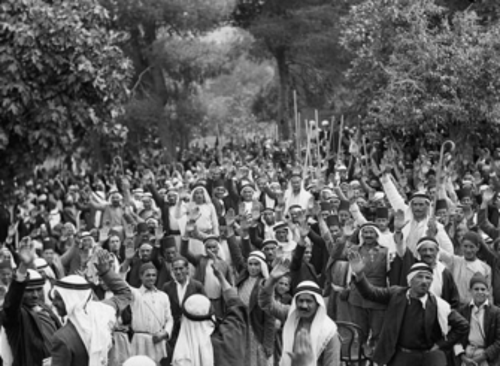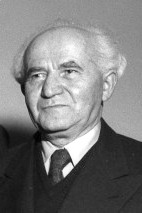Pages in Section 6

The Arab Rebellion Initial Stage
ii. The Arab Rebellion- Strikes, Ambushes and Chaos
ii. Creation of the Notrim
iii. The Peel Commission
The years from 1936 to 1939 were the period of the Arab revolt or "The Troubles" as it came to be known. Basic causes were a steady stream of European Jews and apparent British indifference to Arab protests.
The flash point occurred on 15th April, 1936 when Arab bandits murdered two Jews on the Tulkarm-Nablus Road. On the following day, members of the Irgun murdered two Arabs workmen in a hut near Petah Tikva. Events escalated from then on.

Arabs congregated to listen to calls to action.
In the photo most Arabs are wearing the traditional white hatta wa agal which, in 1936, would indicate they were rural Arabs. A few wear fez, more likely to be worn by city dwellers. Since most fez wearers appear to be young, they are possibly students.
 At the Jewish funerals in Tel Aviv, a huge crowd, surrounded by a police cordon, listened to David Ben Gurion chastising the government for failing to provide protection against highway robbery.
At the Jewish funerals in Tel Aviv, a huge crowd, surrounded by a police cordon, listened to David Ben Gurion chastising the government for failing to provide protection against highway robbery.
"It doesn't take much time to murder three men in cold blood but it does take time to drag rocks and oil drums across a main road and ambush ten cars. Where was the police presence in this notorious black spot? We call upon the government to instigate hourly patrols along that route."
Most cheered his speech but a group at the back of the crowd chanted anti-British slogans and threw stones at the police While the police defended themselves, a section of the crowd surged towards Jaffa chanting anti-Arab slogans. A large number of police chased after them. Jewish youths began beating Arab shoe shine boys on the periphery of the crowd with stout sticks. Older men punched an Arab lemonade seller to the ground and proceeded to kick him until the police pulled them off. Exaggerated rumours of what had occurred at the funeral spread far and wide leading to Arab mobs attacking Jews and the Haganah temporarily evacuating Jewish residents from Jaffa.
The CID later discovered that the gang responsible for shooting the three Jews on the bus were led by 80 year old Sheik Farhan es-Sa'adi, who had played a significant role in both the 1929 riots and al-Qassam's 1935 rebellion.
In Nablus the Arabs formed a 'National Committee' and declared a general strike. Similar 'Committees ' were formed in most Arab cities and in the larger towns. The Supreme Arab Committee endorsed the decision to strike until such time as the British Government changed its policy regarding Jewish immigration. They also called for an absolute prohibition of transfers of Arab land to Jews.